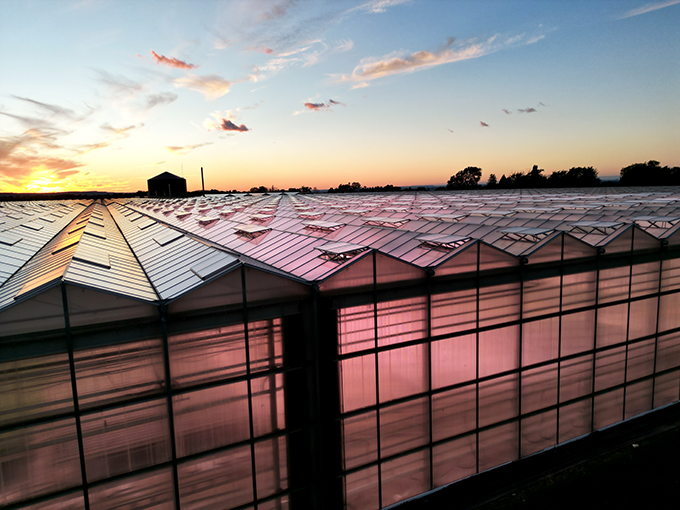Installation
A light plan is important because it provides an accurate account of how many lights you will need for your specific geographic location and greenhouse footprint. But a good greenhouse light plan does so much more.
It helps you:
- Define your supplementary greenhouse lighting needs based on natural light simulations and daily light integral (DLI) analyses.
- Ensure the best setup of your lights and light zones.
- Save energy by optimizing your energy usage.
Read more and get a customized light plan: Light Planning
The quantity of the lights is calculated based on several factors such as growth environment, crop selection, required spectrum, target intensity for the specific crop, and design of the growth chamber/greenhouse which determines the spacing between the lights. It is also important to note that the selection of a high efficiency light like MITRA X would decrease the number of lights needed for installation.
Get a free light plan and find out how many lights are needed for your project here: Light Planning
Light uniformity is important to ensure that light quality and intensity in evenly distributed to avoid variation in plant growth.
Contact our team here and we will help you with your transition into more energy-efficient lighting.
We are more than happy to help you with your lighting needs. Please contact us through our form here: Contact us
LED lights are better than HPS lights due to their superior energy efficiency, longer lifespan, improved light quality, reduced heat emission, and instant illumination. LED offers a more sustainable and cost-effective lighting solution for various applications than HPS.
Read more about our LED lights and their benefits here: LED Grow Lights
Products/Offers
helioSPEC offers broad spectra options to meet the growers needs in optimizing the lighting strategies for any crop at any growth stage, at any geographic location or growth environment.
Read more here: LED Grow Lights
All lighting systems produce heat, but they dissipate it differently. Our systems are either active cooled (DYNA and ELIXIA) or convection cooled (MITRA X).
Read more about our lights: Led Grow Lights
Heliospectra can offer different trail programs where you together with our helioCARE team ensure that you find the right solution for your needs.
Read more and send us an inquiry here: HelioCARE, Crop services
helioCARE is the name of our technical services program, which offers a range of services including light plans, commercial crop trials, cultivation training and consulting, and installation services.
Read more about what we can help you with and contact us here: HelioCARE, Crop services
SMART Lighting Control
helioCORE control system gives you control and flexibility to improve energy savings, optimize plant growth, and streamline operational efficiency. It includes features like the implementation of weather forecasting in the DLI controller, a graphical interface of the installation with a drag-and-drop feature for creating zones, and a data overview of the environment.
Dynamic lighting allows the user to change the output from the lamp with respect to intensity and/or spectral quality as well as area (zoning). There are several ways to work with dynamic lighting; real-time, over the day, season, growth stage or specific treatments. Real-time dimming in the different zones is possible with SMART lighting control.
Want to know more? Read about the impact of Dynamic Light at one of our customers here: Impact of Dynamic Light
Light
PAR (Photosynthetically Active Radiation) is the range of light on the spectrum between 400 and 700 nm that plants use for photosynthesis.
Learn more about Horticulture Lighting Metrics here: Understand LED Grow Lights
Photosynthetic Photon Flux (PPF) is how much PAR light a fixture emits. Photon flux (PF) is the total amount of photons, all light, that come out from the fixture.
Learn more about Horticulture Lighting Metrics here: Understand LED Grow Lights
How effective a fixture converts electricity into photons. The unit is µmol/J, micromoles per joule. This only includes PAR light and not UV and Far-red light.
Far-red radiation refers to photons with wavelengths from 700 to 800 nanometers (nm). It has an effect on plant growth influencing the size of leaves, the length of stems, and ultimately the height of plants. For some plants, far-red light also promotes flowering.
Learn more about Far-Red through our new free ebook! Download here
PPFD (Photosynthetic Photon Flux Density) measures light intensity. It measures the amount of light within PAR that falls on a given surface (for example, the plant canopy area) each second. The unit used to express PPFD is micromoles of photons per square meter per second (μmol/m2/s).
PFD is the Photon Flux Density and accounts for all the light that hits the surface, including UV and Far-red.
Learn more about Horticulture Lighting Metrics here: Understand LED Grow Lights
The light quality is the distribution of the light spectrum, including UV, blue, green, red, and far-red photons. The proportion and ratio between each wavelength are responsible for specific physiological and morphological effects on plants.
Learn more about light quality in this article: Far-Red and Application Timing
DLI stands for Daily Light Integral. DLI is the amount of PAR (Photosynthetically Active Radiation) that is received by your plants over the course of a 24-hour day. It is a measurement of light intensity x photoperiod and is expressed in moles of photons (mols) per square meter (m2) per day (d).
Learn more about DLI through our free ebook: Download here!



